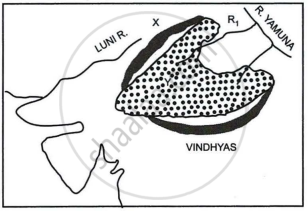Advertisements
Advertisements
प्रश्न
Answer the following question:
The figure below represents a topographic section from the Himalayas to the Peninsular region. Identify any two of the features marked A, B, C, and D.
उत्तर
A – Shivaliks or the outer Himalayas.
B – Bhabar.
C – Bhangar.
D – Khadar.
APPEARS IN
संबंधित प्रश्न
Name the four Indian geological eras in their chronological order.
Briefly explain the geological evolution of the Himalayas.
Give reasons for the following
(i) There is a dense network of railways over the North Indian Plains.
(ii) Peninsular Plateau has a high proportion of metalled roads.
(iii) A good transport network promotes industrial development.
Answer the following question.
Explain the formation of Himalayas with reference to the theory of Plate Tectonics.
Answer the following question:
The figure below represents a section from the Aravalis to the Peninsular region.

Identify any two of the relief features marked, A, B, C, and D.
(i) Where is the New Mangalore Port located?
(ii) What is the chief importance of this port?
Mention any two characteristics features of the Himalayas.
Study the sketch map given below and answer the questions that follow:

- Identify the dotted region marked Y. Mention any three of its characteristic features.
- Name the mountain range marked X, the river marked R1 and the type of rock that constitutes the dotted region.
Assertion: The Himalayas were formed due to the collision of tectonic plates.
Reason: Indian plate moved northwards and pushed beneath the Eurasian Plate leading to the compression of sediments in the Tethys Sea.
India is referred to as a sub-continent. Justify.
